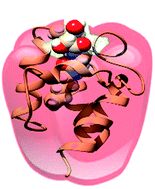A novel antimicrobial target—expanded and revisited mode of action of pantothenamides†
Abstract
Pantothenamides are analogs of pantothenic acid (vitamin B5), which is a natural precursor of coenzyme A (CoA). It has been shown that these compounds, predominantly N-substituted pantothenamides, possess antimicrobial activity against various pathogenic bacteria such as E. coli and S. aureus. It is widely accepted that these compounds act through combined inhibition of coenzyme A and fatty acid synthesis. However, the precise mechanism of action remains unrevealed. Here is reported the identification of a novel target of pantothenamides, never considered before. Molecular dynamics simulations together with free energy calculations reveal that the hydrophobic pocket of the acyl carrier protein (ACP) binds N-pentylpantothenamide. Consequently, the sequestration of the acyl chain attached to the Ppant prosthetic arm is defunct since the inhibitor occupies the hydrophobic core of the ACP. Thus, the acyl chain remains solvent-exposed and susceptible to hydrolysis. Moreover, the ACP with N-pentylpantothenamide bound could change its chain-flipping ability as well as its interaction propensity towards downstream enzyme partners of the fatty acid synthesis pathway, which could result in the suppression of the fatty acid synthesis rate.


 Please wait while we load your content...
Please wait while we load your content...